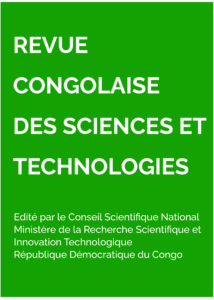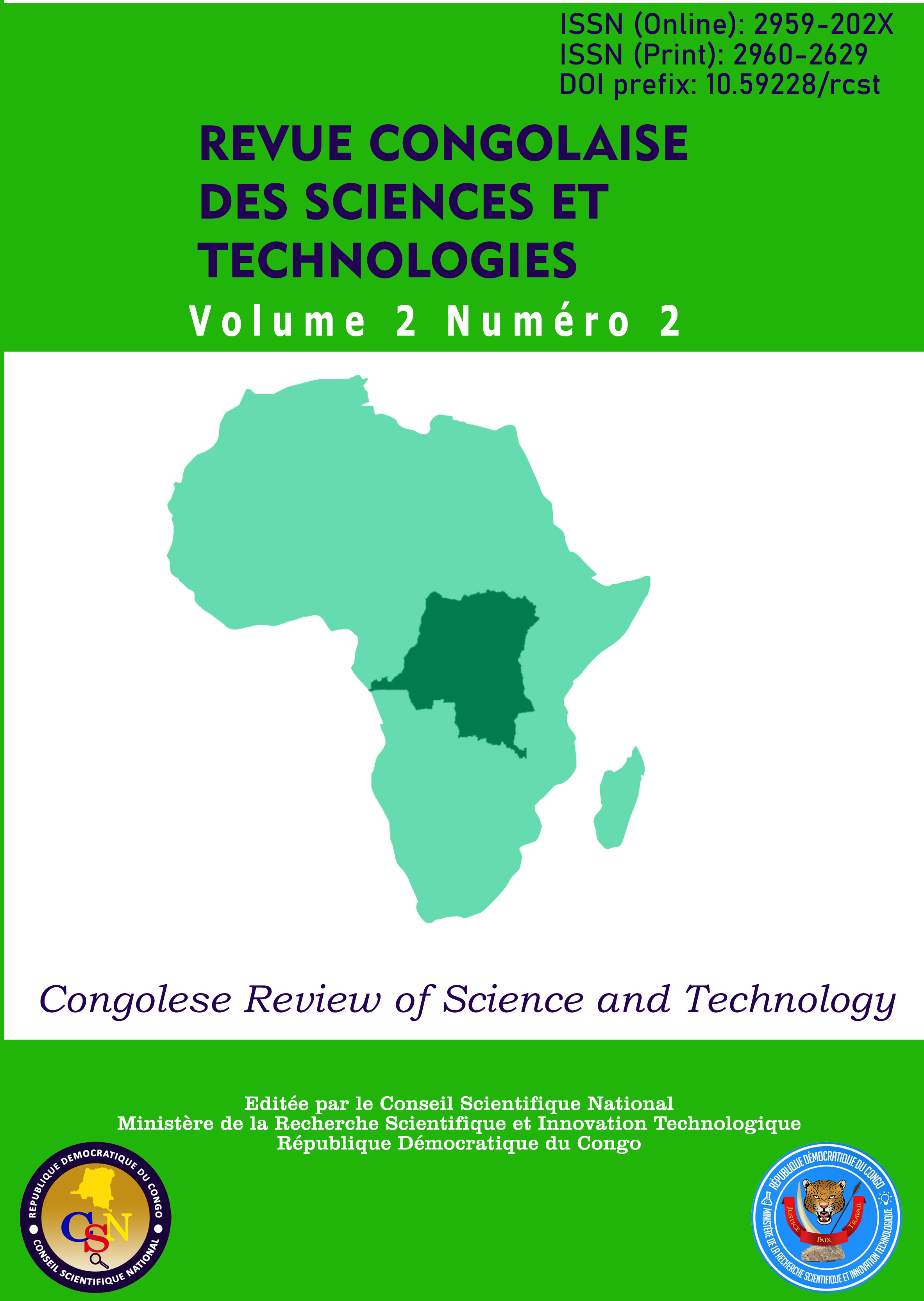Enquête ethnobotanique sur les plantes médicinales utilisées dans le bassin de la rivière Ebola (Réserve Forestière d’Abumombazi) en République démocratique du Congo
Contenu principal de l'article
Résumé
La présente étude avait pour but d’inventorier les plantes médicinales utilisées dans le bassin de la rivière Ebola en
République Démocratique du Congo. La majorité (81,8%) des enquêtés est composée des hommes (vs 18,2% des femmes).
La majorité (52,9%) des enquêtés a niveau d’études secondaires ; 29,8% ont un niveau d’études primaires et près de 1,0 %
(soit, 0,8%) a un niveau d’études universitaires. 41,3% des enquêtés ont l’âge compris entre 31-45 ans ; 29,8% des enquêtés
ont entre 18-30 ans, 25,6% ont un âge supérieur à 45 ans et 3.3% des enquêtés sont âgés de moins de 18 ans. 82.6% des
enquêtés sont des mariés, tandis que 17,4% sont des célibataires. Chez 48,8% des enquêtés, la taille de ménage est composé
de 5-10 personnes. 38,0% ont une taille de ménages de moins de 5 personnes, 8,3% des ménages ont entre 11-15 personnes et
5,0 % de ménages ont plus de 15 personnes. 32 espèces végétales (dont cinq non encore identifiées) ont été répertoriées et
appartiennent à 26 genres et 19 familles. Les principales parties utilisées sont la feuille (40,6%) et la racine (31,3%). 96,9%
des enquêtés utilisent la drogue à l’état frais, tandis qu’à peine 3,1% l’utilisent à l’état sec. La douleur générale, la faiblesse
sexuelle, la douleur lombaire et la carie dentaire sont les principales maladies soignées par ces plantes médicinales. 90,6% des
enquêtés estiment que les malades guérissent après le traitement. A part, le rôle médicinal, les plantes inventoriées sont aussi
utilisées la zone comme bois-énergie ou bois d’œuvre. L’identification des ressources forestières ainsi que leur valorisation et
leur protection deviennent un devoir impérieux dans le Nord Ubangi afin de contribuer aux stratégies de son développement
durable.
Details de l'article

Ce travail est disponible sous licence Creative Commons Attribution - Pas d’Utilisation Commerciale - Partage dans les Mêmes Conditions 4.0 International.
Références
Alalwan T. A., Alkhuzai J. A., Jameel Z., Mandeel
Q. A. (2019). Quantitative ethnobotanical
study of some medicinal plants used by
herbalists in Bahrain. Journal of Herbal
Medicine, 17-18: 100278.
https://doi.org/10.1016/j.hermed.2019.100278
Amjad M. S., Qaeem M. F., Ahmad I., Khan S. U.,
Chaudhari S. K., Zhaid M. N., et al., (2017).
Descriptive study of plant resources in the
context of the ethnomedicinal relevance of
indigenous flora: A case study from Toli Peer
National Park, Azad Jammu and Kashmir,
Pakistan. PLoS ONE, 12 (2): e0171896.
https://doi.org/10.1371/journal.pone.0171896
Amujoyegbe O.O., Idu M., Agbedahunsi J.M.,
Erhabor J.O. (2016). Ethnomedicinal survey
of medicinal plants used in the management of
sickle cell disorder in Southern Nigeria.
Journal of Ethnopharmacology, 185 : 347-
https://doi.org/10.1016/j.jep.2016.03.042
APG (Angiosperm Phylogeny Group) III. 2009. An
update of the Angiosperm Phylogeny Group
classification for the orders and families of
flowering plants. APG III. Botanical Journal
of the Linnean Society 161: 105–
https://doi.org/10.1111/j.1095-
2009.01000.x
Asimonyio J.A., Ngabu J.C., Lomba C.B., Falanga
C.M., Mpiana P.T., Ngbolua K.N. (2015).
Structure et diversité d’un peuplement
forestier hétérogène dans le bloc sud de la
réserve forestière de Yoko (Ubundu,
République Démocratique du Congo).
International Journal of Innovation and
Scientific Research, 18: 241-251.
Faruque M. O., Feng G., Khan Md. N. A., Barlow J.
W., Ankhi U R.., Hu S., et al. (2019).
Qualitative and quantitative ethnobotanical
study of the Pangkhua community in
Bilaichari Upazilla, Rangamati District,
Bangladesh. Journal of Ethnobiology and
Ethnomedicine, 15: 8.
https://doi.org/10.1186/s13002-019-0287-2
Ilumbe Bayeli G., 2010. Utilisation des plantes en
médecine traditionnelle par les Pygmées (BaTwa) et les Bantous (Ba-Oto) du territoire de
Bikoro, Province de l’Équateur en République
Démocratique du Congo. Thèse de doctorat,
Université libre de Bruxelles, Belgique.
https://difusion.ulb.ac.be/vufind/Record/ULB
DIPOT:oai:dipot.ulb.ac.be:2013/210007/TOC
Junsongduang A., W. Kasemwan, S. Lumjoomjung,
W. Sabprachai, W. Tanming and H. Balslev.
Ethnomedicinal Knowledge of
Traditional Healers in Roi Et, Thailand.
Plants, 9: 1177.
https://doi.org/10.3390/plants9091177
Kambale J.-L.K., Asimonyio J.A., Shutsha R.E.,
Katembo E.W., Tsongo J.M., Kavira P.K.,
Yokana E.I., Bukasa K.K., Nshimba H.S.,
Mpiana P.T., Ngbolua K.N. (2016a). Études
floristique et structurale des forêts dans le
domaine de chasse de Rubi-Télé (Province de
Bas-Uélé, République Démocratique du
Congo). International Journal of Innovation
and Scientific Research, 24 : 309-32.
Kambale J.-L.K., Shutsha R.E., Katembo E.W.,
Omatoko J.M., Kirongozi F.B., Basa O.D.,
Bugentho E.P., Yokana E.I., Bukasa K.K., Nshimba H.S., Ngbolua K.N. (2016b). Étude
floristique et structurale de deux groupements
végétaux mixtes sur terre hydromorphe et
ferme de la forêt de Kponyo (Province du
Bas-Uélé, R.D. Congo). International Journal
of Innovation and Scientific Research, 24:
-308.
Kumar P., Lalramnghinglova H. 2011. India with
special reference to an Indo Burma hotspot
region. Ethnobotany Research & Applications,
-420. https://doi.org/10.
/era.9.0.379-420
Lautenschläger T., Monizi M., Pedro M., Mandombe
J.L., Bránquima M.F., Heinze C., Neinhuis C.
(2018). First large-scale ethnobotanical survey
in the province of Uíge, northern
Angola. Journal of Ethnobiology and
Ethnomedicine, 14: 51.
https://doi.org/10.1186/s13002-018-0238-3.
Mongeke M.M., Ngbolua K.N., Bakola R.D., Inkoto
C.L., Elikandani P.N., Mowuli C.Y. (2018).
Survey on the plants used in Traditional
medicine by Bambenga: Pygmy from Dongo
Sector (Territory of Kungu, Province of SudUbangi) in Democratic Republic of the
Congo. Revue Marocaine des Sciences
Agronomiques & Vétérinaires, 6 (4): 469-475.
Ngbolua K.N., Rafatro H., Rakotoarimanana H.,
Urverg R.S., Mudogo V., Mpiana P.T.,
Tshibangu D.S.T. (2011a). Pharmacological
screening of some traditionally-used
antimalarial plants from the Democratic
Republic of Congo compared to its ecological
taxonomic equivalence in Madagascar.
International Journal of Biological
and Chemical Sciences, 5: 1797-1804.
Ngbolua K.N., Rakotoarimanana H., Rafatro H.,
Urverg S.R., Mudogo V., Mpiana P.T.,
Tshibangu D.S.T. (2011b). Comparative
antimalarial and cytotoxic activities of two
Vernonia species: V. amygdalina from the
Democratic Republic of Congo and V. cinerea
subsp vialis endemic to Madagascar.
International Journal of
Biological and Chemical Sciences, 5: 345-
Ngbolua K.N., Benamambote B.M., Mpiana P.T.,
Muanda D.M, Ekutsu E.G., Tshibangu D.S.T.,
Gbolo B.Z., Muanyishay C.L., Basosila N.B.,
Bongo G.N., Robijaona B. (2013a). Ethnobotanical survey and Ecological Study of
some Medicinal Plants species traditionally
used in the District of Bas-Fleuve (Bas-Congo
Province, Democratic Republic of Congo).
Research Journal of Chemistry, 1: 01-10.
Ngbolua K.N., Mpiana P.T., Mudogo V., Ngombe
N.K., Tshibangu D.S.T., Ekutsu E.G., Kabena
O.N., Gbolo B.Z., Muanyishay L. (2014a).
Ethno-pharmacological survey and Floristical
study of some Medicinal Plants traditionally
used to treat infectious and parasitic
pathologies in the Democratic Republic of
Congo. International Journal of Medicinal
Plants, 106: 454-467.
Ngbolua K.N. (2018). Données préliminaires sur la
biodiversité du Nord-Ubangi en République
démocratique du Congo. Editions
Universitaires Européennes, Riga : Latvia.
ISBN : 978-613-8-44529-6.
Ngbolua K.N. (2020). Quantitative ethnobotany:
Methodological approach for the evaluation
and valorization of endogenous knowledge
in tropical regions. Sciancia Scripts
Publisher: Mauritius. ISBN: 978-620-2-
-2.
Ong H.G., Kim Y.D. 2020. Medicinal plants for
gastrointestinal diseases among the Kuki-Chin
ethnolinguistic groups across Bangladesh,
India, and Myanmar: a comparative and
network analysis study. Journal of
Ethnopharmacology, 251:112415.
https://doi.org/10.1016/j.jep.2019.112415.
Pathy K.K, Flavien N. B., Honoré BK, W. Vanhove,
P. Van Damme. (2021). Ethnobotanical
characterization of medicinal plants used in
Kisantu and Mbanza-Ngungu territories,
Kongo-Central Province in DR Congo.
Journal of Ethnobiology and Ethnomedicine,
:5. https://doi.org/10.1186/s13002-020-
-7.
Ribeiro R.V., Bieski I.G.C., Balogun S.O., Martins
D.T.O. (2017). Ethnobotanical study of
medicinal plants used by Ribeirinhos in the
North Araguaia microregion, Mato Grosso,
Brazil. Journal of Ethnopharmacology, 205 :
-102.
https://doi.org/10.1016/j.jep.2017.04.023.
Rusaati B. I. W., Gendusa A. P., Joo S. H., Park J.
W., Masumbuko N. C., Iragi K. G., Ngbolua
K.-T.-N., Furaha M. A., Rolly N. K., Kang J.
W. (2021). A systematic review of
antimalarial medicinal plants in Democratic
Republic of the Congo. Bois et Forêts des
Tropiques, 347 : 11-27.
https:/doi.org/10.19182/bft2021.347.a31882.
Srithi K., Balslev H., Wangpakapattanawong P.,
Srisanga P., Trisonthi C. (2009). Medicinal
plant knowledge and its erosion among the
Mien (Yao) in northern Thailand. Journal of
Ethnopharmacology, 123(2): 335-42.
https://doi.org/10.1016/j.jep.2009.02.035
Umair M., Altaf M., Bussmann R. W., Abbasi A. M.
(2019). Ethnomedicinal uses of local flora in
Chenab riverine area, Punjab province,
Pakistan. Journal of Ethnobiology and
Ethnomedicine, 15: 7.
https://doi.org/10.1186/s13002-019-0285-4.
World Health Organization (2002). Traditional
medicine strategy 2002-2005.
http://www.who.int/medicines/library/trm trat
eng.pdf .

